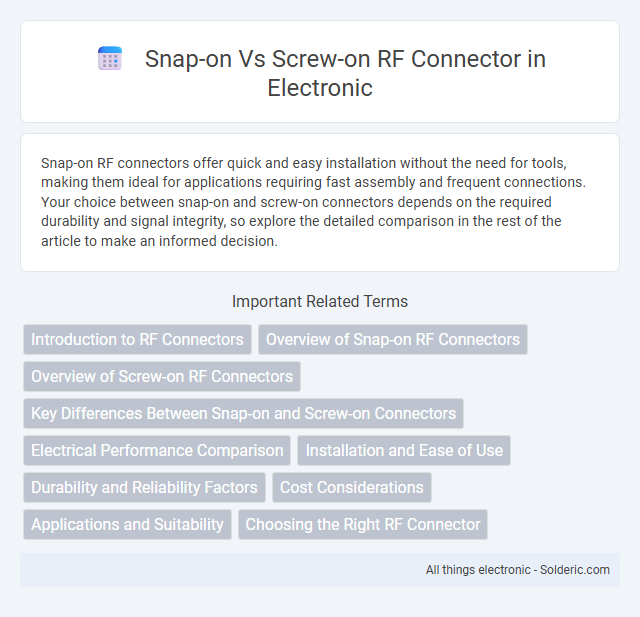Snap-on RF connectors offer quick and easy installation without the need for tools, making them ideal for applications requiring fast assembly and frequent connections. Your choice between snap-on and screw-on connectors depends on the required durability and signal integrity, so explore the detailed comparison in the rest of the article to make an informed decision.
Comparison Table
| Feature | Snap-on RF Connector | Screw-on RF Connector |
|---|---|---|
| Connection Mechanism | Quick push and lock | Threaded screw tightening |
| Installation Speed | Fast, tool-free | Slower, requires tools |
| Signal Integrity | Moderate, suitable for low to medium frequencies | High, ideal for high-frequency applications |
| Durability | Less resistant to vibration | Highly resistant to mechanical stress |
| Use Cases | Consumer electronics, quick testing | Professional RF equipment, long-term installations |
| Cost | Generally lower | Usually higher |
| Maintenance | Easy and quick replacement | Requires careful tightening and checking |
Introduction to RF Connectors
RF connectors are critical components in wireless communication systems, enabling the transmission of radio frequency signals with minimal loss. Snap-on RF connectors offer quick, tool-free installation ideal for applications requiring frequent connections and disconnections, while screw-on RF connectors provide secure, robust connections that ensure stable performance in environments with vibration or mechanical stress. Understanding the differences in design and application helps optimize system reliability and signal integrity in various RF setups.
Overview of Snap-on RF Connectors
Snap-on RF connectors offer a quick and tool-free connection method, providing efficient assembly and disassembly for RF applications. These connectors utilize a reliable mechanical locking mechanism that ensures secure contact while minimizing wear on the components, ideal for testing and measurement devices. Snap-on connectors enhance signal integrity through precision engineering, suitable for environments requiring frequent cable changes without compromising performance.
Overview of Screw-on RF Connectors
Screw-on RF connectors provide secure, threaded connections ideal for applications requiring robust mechanical strength and reliable signal integrity. These connectors are widely used in environments where vibration or movement could loosen connections, ensuring stable performance in RF systems. Their design supports a wide range of frequencies, making them suitable for telecommunications, aerospace, and industrial communication equipment.
Key Differences Between Snap-on and Screw-on Connectors
Snap-on RF connectors provide quick and easy attachment through a simple push-on mechanism, ideal for applications requiring frequent connections and disconnections. Screw-on RF connectors offer a secure and reliable connection with threaded coupling, ensuring enhanced signal integrity and durability in high-vibration environments. The key differences lie in the convenience and speed of snap-on connectors versus the robust, vibration-resistant design and consistent performance of screw-on connectors.
Electrical Performance Comparison
Snap-on RF connectors offer quicker assembly with consistent electrical performance characterized by low VSWR and stable impedance across high-frequency ranges up to 6 GHz. Screw-on connectors, while requiring longer installation time, provide superior mechanical stability and reduced signal loss in environments with high vibration or temperature fluctuations, maintaining optimal return loss and insertion loss values. Your choice depends on balancing ease of use with the need for robust electrical performance in demanding applications.
Installation and Ease of Use
Snap-on RF connectors offer faster and more convenient installation by allowing users to connect and disconnect cables without tools, making them ideal for applications requiring frequent changes. Screw-on RF connectors provide a more secure and stable connection through threaded coupling, ensuring minimal signal loss but requiring more time and effort to install. The choice depends on balancing ease of use with the need for mechanical durability and signal integrity in specific RF applications.
Durability and Reliability Factors
Snap-on RF connectors offer quick installation but may sacrifice long-term durability compared to screw-on types, which provide a secure, threaded connection ensuring consistent signal integrity under vibration and environmental stress. Screw-on connectors excel in applications demanding high reliability due to their robust mechanical retention and resistance to loosening over time. Choosing the right connector for Your setup hinges on balancing convenience with the need for stable, long-lasting performance in challenging conditions.
Cost Considerations
Snap-on RF connectors generally incur higher upfront costs due to advanced design and quicker installation benefits, making them cost-effective for high-volume or time-sensitive projects. Screw-on RF connectors are typically less expensive per unit but require more assembly time, increasing labor costs in large-scale applications. Evaluating Your project's budget and installation speed will help determine whether initial price or total operational cost holds greater value.
Applications and Suitability
Snap-on RF connectors offer quick and easy connections ideal for high-frequency testing and temporary setups, commonly used in lab environments and broadcast equipment due to their convenience and low insertion loss. Screw-on RF connectors provide secure, durable connections suitable for permanent installations in telecommunications, aerospace, and military applications where vibration resistance and long-term reliability are critical. Your choice between snap-on and screw-on connectors should consider the balance between ease of use and connection stability based on the specific demands of your application.
Choosing the Right RF Connector
Choosing the right RF connector depends on the application's requirements for ease of installation and reliability. Snap-on RF connectors provide quick and tool-free attachment, ideal for situations requiring frequent disconnections or limited access. Screw-on RF connectors offer a secure, stable connection with superior resistance to vibrations, making them suitable for high-performance and critical systems where signal integrity is paramount.
Snap-on vs Screw-on RF connector Infographic

 solderic.com
solderic.com